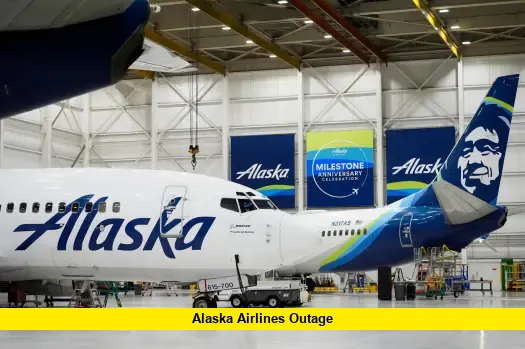The Alaska Airlines outage on October 23, 2025, caused a nationwide ground stop and widespread travel disruption across the United States. The airline confirmed that a major IT system failure at its primary data center led to a complete halt of operations for several hours Thursday afternoon. Although systems have since been restored, the outage affected passengers at dozens of airports and forced hundreds of flight delays and cancellations.
What Happened
The incident began around 3:30 p.m. Pacific Time, when Alaska Airlines’ network systems suddenly went offline. Within minutes, the Federal Aviation Administration issued a nationwide ground stop at the airline’s request. This included both Alaska Airlines and its regional carrier, Horizon Air.
According to the airline’s internal update, several critical systems that handle flight operations, scheduling, and gate coordination failed simultaneously. The outage affected boarding, check-in, and flight management tools, making it impossible for flights to depart or arrive safely.
By evening, operations began to resume gradually as IT engineers restored connectivity. Alaska Airlines emphasized that the issue was due to a technical malfunction and not a cybersecurity attack.
Scope and Passenger Impact
The outage affected flights across all major U.S. hubs where Alaska Airlines operates, including Seattle, Portland, Los Angeles, and San Francisco. Thousands of passengers were impacted, with many reporting long waits inside terminals or being asked to deplane after boarding.
While the exact number of affected flights is still being reviewed, hundreds of delays and dozens of cancellations were reported before operations normalized. Several Alaska and Horizon aircraft remained grounded during the system reset, creating a ripple effect into Friday morning schedules.
To assist stranded travelers, the airline activated a flexible travel policy allowing customers with flights booked for October 23–24 to rebook at no additional cost through October 27. Passengers were also advised to verify their flight status before heading to the airport.
Timeline of Events
| Time (PDT) | Event |
|---|---|
| 3:30 p.m. | Alaska Airlines’ main data center experiences an outage, triggering system failures. |
| 3:45 p.m. | FAA issues a nationwide ground stop for Alaska Airlines and Horizon Air flights. |
| 4:15 p.m. | Passengers report boarding delays and cancellations across multiple U.S. airports. |
| 6:45 p.m. | Alaska Airlines confirms a companywide IT issue and begins restoring systems. |
| 8:00 p.m. | Gradual resumption of flights begins as systems stabilize. |
| 10:30 p.m. | Airline announces full operational recovery, though residual delays remain. |
Airline Statement
Alaska Airlines issued a formal statement late Thursday explaining the cause of the disruption. The company confirmed that a data-center failure led to system downtime affecting “several key platforms” required for safe flight operations. It clarified that no evidence pointed to a security breach or external hack.
The airline also apologized to travelers for the inconvenience, acknowledging that such outages severely impact customer trust and travel plans. “Our teams worked quickly to identify the issue, restore systems, and get our guests safely on their way,” the statement read.
Not the First Outage This Year
This is the second major IT outage Alaska Airlines has suffered in 2025. A similar event in July also grounded flights for roughly three hours before operations were restored. Both incidents have raised concerns among travelers and analysts about the resilience of the airline’s technological infrastructure.
Industry experts note that as airlines become increasingly dependent on complex digital systems for everything from scheduling to aircraft routing, even short outages can cause massive ripple effects across national airspace networks.
Response and Recovery
By early Friday, Alaska Airlines confirmed that its flight schedule had largely stabilized. However, some flights remained delayed due to aircraft and crew repositioning. The airline said it is conducting a thorough internal review to prevent similar disruptions in the future, including evaluating redundancy systems and data-center backup protocols.
Airport operations teams across the U.S. worked overnight to accommodate displaced passengers, rebook flights, and process refunds. The airline’s mobile app and website are now functioning normally, though users were temporarily unable to access booking and check-in tools during the outage.
Impact on Travelers
Travelers flying with Alaska Airlines over the next several days should take the following steps:
- Check flight status on the airline’s website or mobile app before leaving for the airport.
- Arrive early, as airport check-in lines may still be longer than usual.
- Rebook if necessary, using the airline’s flexible policy through October 27.
- Monitor email and text alerts for any schedule changes.
For passengers already affected, the airline is offering compensation options, including refunds for canceled flights and meal vouchers at select airports.
Financial and Operational Implications
The outage comes at a challenging time for Alaska Airlines’ parent company, Alaska Air Group, which recently revised its profit outlook for 2025 due to rising fuel costs and operational challenges. Analysts suggest that this latest disruption could further affect the company’s financial performance and customer confidence.
In recent months, Alaska Airlines has been expanding its network, upgrading aircraft, and investing in digital infrastructure. However, this event underscores the critical need for robust IT redundancy systems across major carriers—particularly as travel demand remains high heading into the winter holiday season.
Looking Ahead
As of October 24, 2025, Alaska Airlines operations have returned to normal, but the company continues to investigate the root cause of the IT failure. The airline has pledged to strengthen its internal systems and minimize the risk of similar disruptions in the future.
For passengers, the key takeaway is clear: digital reliability is now just as vital as mechanical safety in modern air travel. With increasing dependence on interconnected systems, airlines face growing pressure to ensure uninterrupted service across every digital platform they use.
If you were affected by the Alaska Airlines outage, share your experience below and stay tuned for further updates on the airline’s recovery efforts.
